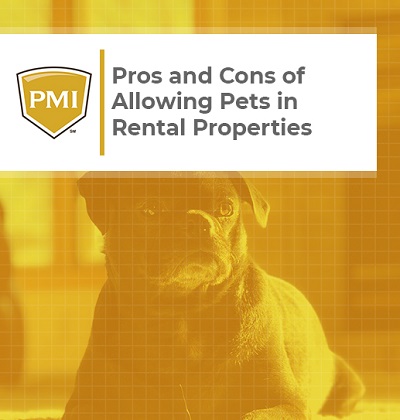
Before finding tenants for your rental property, you first have to decide on a pet policy. The pet policy should indicate if pets are allowed, what types of animals are acceptable, what fees are required, and what rules pet owners must follow during the tenancy. These things must be discussed with renters before the lease signing. As a landlord, you should know the pros and cons of allowing pets in rental properties. Curious what these are? Read this post to find out.
Pros of Allowing Pets in Rental Properties
1. Increase your tenant pool
If you allow pets, there will be more tenants who will be interested in your rental property. More than 75% of renters own pets. But the majority (60%) struggle to find a pet-friendly rental. So if you allow pets, your property will appeal to a larger audience.
2. Make more money
Landlords who allow pets can make more money by charging pet fees or pet rent. About a third of landlords collect pet rent. It is charged monthly and is usually $20 to $100. This payment is added to the baseline rent price and is non-refundable. Even a small amount per month will add up to a considerable sum each year, especially if you have multiple units to rent out.
A pet fee/rent is different from a pet deposit. The pet deposit is a refundable fee paid by tenants when they move in. The purpose of this deposit is to cover any damage that will be caused by the pet. If there is no damage at the end of the lease, you have to return the deposit.
3. Responsible tenants
Pets require constant care and attention. It’s no surprise that most pet owners know the meaning of commitment and responsibility. This quality can translate to being responsible tenants as well (e.g., taking care of the space and paying rent on time).
4. More renewed leases
Pet owners usually have a more difficult time finding a rental compared to those without pets. When they finally find a suitable place and they feel comfortable with it, it is highly likely that they will renew the lease. The reason – as much as possible, they don’t want to go through the hassle of searching for a property that allows pets all over again.
5. Happier tenants
Did you know that the simple act of petting a dog or cat triggers the release of feel-good hormones in humans? Animals are also known to reduce stress and anxiety. If your prospective tenants have pets, chances are, they are happy and loving people. As a landlord, don’t you want that?
Cons of Allowing Pets in Rental Properties
1. Potential damage to your property
Property damage from pets is possible. Dogs and cats can destroy landscaping, chew wood and cables, scratch furniture, and stain surfaces in your rental property. Puppies and certain breeds have a greater tendency to do such things.
2. Noise
Noise can disrupt neighbors and other tenants. If you allow dogs in your property, the dog may bark. So it is best to ask pet owners whether their dog barks and how much. Depending on your particular neighborhood, noise can be a concern.
3. Odor
Pets can produce unpleasant odors. If litter boxes aren’t cleaned regularly or accidents occur in the hallway, offensive odors can build up. Animals that are not properly groomed or bathed can also leave odors inside the unit. Whether it’s due to “accidents”, fur, or hair, your rental property may require extra cleaning to get rid of unpleasant smells.
4. Allergies
With pets come allergens. This is especially true with and cats that shed and long-haired dogs. While the pet owner can tolerate these allergens, other people in the building may not. Allergens can spread through air conditioning ducts and affect common areas.
5. Injury to people or other animals
As a landlord, you don’t want to be liable for injuries caused by your tenant’s pets. To prevent this from happening, make sure your tenant has renters insurance to cover animal bites that occur on the property.
Know What Animals Are Restricted
Some insurance companies and homeowners associations (HOA) have restrictions on certain breeds of dogs, such as:
- Pit bulls
- Rottweilers
- German shepherds
- Doberman pinschers
- Akitas
- Chows
- Siberian huskies
- Alaskan malamutes
- Saint Bernard’s
- Wolf hybrids
The type of restrictions will vary depending on the insurance company or HOA. Check with your agent or HOA to see what restrictions they have, if any.
Screening Questions to Ask Tenants with Pets
Part of the process of evaluating the pros and cons of allowing pets in rental properties is asking the following questions:
- How many pets do you own?
- What are your pet’s breed and size?
- How old is your pet?
- How long have you owned your pet?
- Has there been any instance where your pet acted aggressively towards other people or any other animals?
- Are you solely responsible for your pet?
- Is your pet trained?
- Are your pet/s updated on their vaccines?
- Does your pet get along well with other people, children, and other animals?
Conclusion
It’s important to weigh the pros and cons of allowing pets in rental properties. You may want to check your insurance policy to determine what type of coverage you have if you decide to allow pets. Check the amount of liability coverage and see if there are any limitations or exclusions. Deciding if you should allow pets can impact how much profit you make and how many renters will be interested in your property. Therefore, deciding whether to make your property pet-friendly requires careful thought and should not be taken lightly.
Interested in renting out your property? Contact PMI today!

